Related Research Articles

Origami is the Japanese art of paper folding. In modern usage, the word "origami" is often used as an inclusive term for all folding practices, regardless of their culture of origin. The goal is to transform a flat square sheet of paper into a finished sculpture through folding and sculpting techniques. Modern origami practitioners generally discourage the use of cuts, glue, or markings on the paper. Origami folders often use the Japanese word kirigami to refer to designs which use cuts.
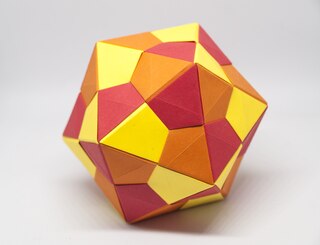
Modular origami or unit origami is a two-stage paper folding technique in which several, or sometimes many, sheets of paper are first folded into individual modules or units and then assembled into an integrated flat shape or three-dimensional structure, usually by inserting flaps into pockets created by the folding process. These insertions create tension or friction that holds the model together.

A silversmith is a metalworker who crafts objects from silver. The terms silversmith and goldsmith are not exact synonyms, as the techniques, training, history, and guilds are largely the same but differed in that the end product may vary greatly.

Repoussé or repoussage ( ) is a metalworking technique in which a malleable metal is shaped by hammering from the reverse side to create a design in low relief. Chasing or embossing is a similar technique in which the piece is hammered on the front side, sinking the metal. The two techniques are often used in conjunction.

Paper craft is a collection of crafts using paper or card as the primary artistic medium for the creation of two or three-dimensional objects. Paper and card stock lend themselves to a wide range of techniques and can be folded, curved, bent, cut, glued, molded, stitched, or layered. Papermaking by hand is also a paper craft.
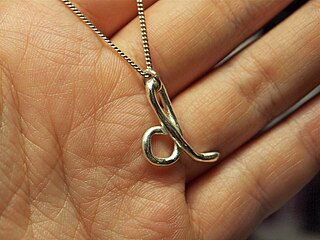
Metal clay is a crafting medium consisting of very small particles of metal such as silver, gold, bronze, or copper mixed with an organic binder and water for use in making jewelry, beads and small sculptures. Originating in Japan in 1990, metal clay can be shaped just like any soft clay, by hand or using molds. After drying, the clay can be fired in a variety of ways such as in a kiln, with a handheld gas torch, or on a gas stove, depending on the type of clay and the metal in it. The binder burns away, leaving the pure sintered metal. Shrinkage of between 8% and 30% occurs. Alloys such as bronze, sterling silver, and steel also are available.

A metalsmith or simply smith is a craftsperson fashioning useful items out of various metals. Smithing is one of the oldest metalworking occupations. Shaping metal with a hammer (forging) is the archetypical component of smithing. Often the hammering is done while the metal is hot, having been heated in a forge. Smithing can also involve the other aspects of metalworking, such as refining metals from their ores, casting it into shapes (founding), and filing to shape and size.
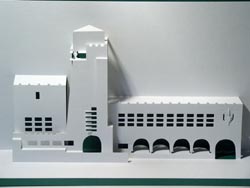
Origamic architecture is a form of kirigami that involves the three-dimensional reproduction of architecture and monuments, on various scales, using cut-out and folded paper, usually thin paperboard. Visually, these creations are comparable to intricate 'pop-ups', indeed, some works are deliberately engineered to possess 'pop-up'-like properties. However, origamic architecture tends to be cut out of a single sheet of paper, whereas most pop-ups involve two or more. To create the three-dimensional image out of the two-dimensional surface requires skill akin to that of an architect.
The following outline is provided as an overview of and topical guide to crafts:

Planishing is a metalworking technique that involves finishing the surface of sheet metal by finely shaping and smoothing it.
Arline Fisch is an American artist and educator. She is known for her work as a metalsmith and jeweler, pioneering the use of textile processes from crochet, knitting, plaiting, and weaving in her work in metal. She developed groundbreaking techniques for incorporating metal wire and other materials into her jewelry.
Tim McCreight is an American artist who specializes in metalsmithing, particularly in jewelry. He is also an author of books referring to metalsmithing.
Diane Falkenhagen is an American artist, she is known as a metalsmith and creates mixed-media custom jewelry which incorporates two dimensional imagery. She is based in Texas.

Mary Lee Hu is an American artist, goldsmith, and college level educator known for using textile techniques to create intricate woven wire jewelry.

Fred Fenster is a metalsmith and professor emeritus of the University of Wisconsin at Madison where he taught art and education. He is particularly known for his work in pewter, influencing generations of metalsmiths. Fenster was named a Fellow of the American Craft Council in 1995.

Native American jewelry refers to items of personal adornment, whether for personal use, sale or as art; examples of which include necklaces, earrings, bracelets, rings and pins, as well as ketohs, wampum, and labrets, made by one of the Indigenous peoples of the United States. Native American jewelry normally reflects the cultural diversity and history of its makers, but tribal groups have often borrowed and copied designs and methods from other, neighboring tribes or nations with which they had trade, and this practice continues today. Native American tribes continue to develop distinct aesthetics rooted in their personal artistic visions and cultural traditions. Artists may create jewelry for adornment, ceremonies, and display, or for sale or trade. Lois Sherr Dubin writes, "[i]n the absence of written languages, adornment became an important element of Indian communication, conveying many levels of information." Later, jewelry and personal adornment "...signaled resistance to assimilation. It remains a major statement of tribal and individual identity."
Gary Lee Noffke is an American artist and metalsmith. Known for versatility and originality, he is a blacksmith, coppersmith, silversmith, goldsmith, and toolmaker. He has produced gold and silver hollowware, cutlery, jewelry, and forged steelware. Noffke is noted for his technical versatility, his pioneering research into hot forging, the introduction of new alloys, and his ability to both build on and challenge traditional techniques. He has been called the metalsmith's metalsmith, a pacesetter, and a maverick. He is also an educator who has mentored an entire generation of metalsmiths. He has received numerous awards and honors. He has exhibited internationally, and his work is represented in collections around the world.
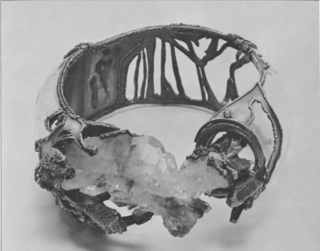
Eleanor Moty, is an American metalsmith and jewelry artist. Her experimentation with industrial processes, such as photoetching and electroforming, was revolutionary in the field of American art jewelry in the 1960s and 1970s.
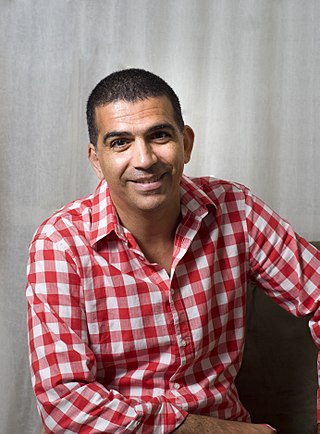
Ilan Garibi is an Israeli origami artist and designer. He started his way in the world of art and design as a paper origami artist, and today also designs furniture, jewelry and works of art out of a variety of materials, such as metals, wood, and glass. He masters an origami genre called Tessellation. During 2012 he co-established Origamisrael, the Israeli origami artists' organization, and he is its chairman ever since. He is an author of several books in the fields of origami and puzzles. In September 2019, Garibi presented a TEDx talk as part of TEDxPaloAltoSalon.

In metalwork, reticulation refers to a decorative surface finishing technique involving the application of localised heat to the surface of a metal object. Reticulation is typically performed on alloys of silver and copper or of gold and copper.
References
- ↑ Lewton-Brain, Charles (2008). Foldforming. Hong Kong: Btrynmorgen Press. pp. Title, pgs 11, 12, 15, and throughout the book. ISBN 978-1-929565-26-9.
- 1 2 Isherwod, B. (2013). Nature and Structure: The Balancing Act of Charles Lewton-Brain. Metalsmith, 33(1), 46–53.
- ↑ Email sent by Charles Lewton-Brain on 8/8/2015: "Studied at the Fachhochschule fur Gestalstung in Pforzheim."
- ↑ Removed reference to Origami. Email from Charles Lewton-Brain 8/8/2016: "Not really influenced by origami, that was more something that other people used to describe foldforming, not me. You can do origami in metal, and I looked at it a little bit near the beginning, but in foldforming it is about plasticity"
- 1 2 3 4 5 McCreight, T., & Johnston, A. (2008). Fold Forming Charles Lewton-Brain Archived 2016-10-10 at the Wayback Machine . 1–23.
- ↑ Jobst, R. (2009). Vines, Veins, and Morning Glories: An Examination of Arboreal Patterns in Relation to the Hypothesis. 1–44.
- 1 2 Qattawi, A. (2012). Extending Origami Technique to Fold Forming of Sheet Metal Products. All Dissertations. Paper 1392.
- ↑ McCreight, Tim, ed. Metals Technic. Brynmorgen, 1992. pp 71–87 ISBN 0-9615984-3-3